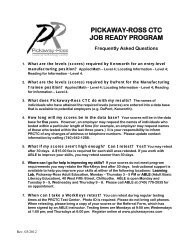Commons
Conceptual Physics - elearning-phys
Conceptual Physics - elearning-phys
- No tags were found...
Create successful ePaper yourself
Turn your PDF publications into a flip-book with our unique Google optimized e-Paper software.
that this wasn’t really an argument about the earth’s motion butabout physics. In one of his books, which were written in the formof dialogues, he has the three characters debate what would happenif a ship was cruising smoothly across a calm harbor and a sailorclimbed up to the top of its mast and dropped a rock. Would it hitthe deck at the base of the mast, or behind it because the ship hadmoved out from under it? This is the kind of experiment referred toin the principle of inertia, and Galileo knew that it would come outthe same regardless of the ship’s motion. His opponents’ reasoning,as represented by the dialog’s stupid character Simplicio, was basedon the assumption that once the rock lost contact with the sailor’shand, it would naturally start to lose its forward motion. In otherwords, they didn’t even believe in the idea that motion naturallycontinues unless a force acts to stop it.But the principle of inertia says more than that. It says thatmotion isn’t even real: to a sailor standing on the deck of the ship,the deck and the masts and the rigging are not even moving. Peopleon the shore can tell him that the ship and his own body are movingin a straight line at constant speed. He can reply, “No, that’s anillusion. I’m at rest. The only reason you think I’m moving isbecause you and the sand and the water are moving in the oppositedirection.” The principle of inertia says that straight-line, constantspeedmotion is a matter of opinion. Thus things can’t “naturally”slow down and stop moving, because we can’t even agree on whichthings are moving and which are at rest.If observers in different frames of reference disagree on velocities,it’s natural to want to be able to convert back and forth. For motionin one dimension, this can be done by simple addition.A sailor running on the deck example 3⊲ A sailor is running toward the front of a ship, and the othersailors say that in their frame of reference, fixed to the deck, hisvelocity is 7.0 m/s. The ship is moving at 1.3 m/s relative to theshore. How fast does an observer on the beach say the sailor ismoving?⊲ They see the ship moving at 7.0 m/s, and the sailor moving evenfaster than that because he’s running from the stern to the bow.In one second, the ship moves 1.3 meters, but he moves 1.3+7.0m, so his velocity relative to the beach is 8.3 m/s.The only way to make this rule give consistent results is if wedefine velocities in one direction as positive, and velocities in theopposite direction as negative.Running back toward the stern example 4⊲ The sailor of example 3 turns around and runs back towardthe stern at the same speed relative to the deck. How do theother sailors describe this velocity mathematically, and what doSection 1.4 Conservation of Energy 19



